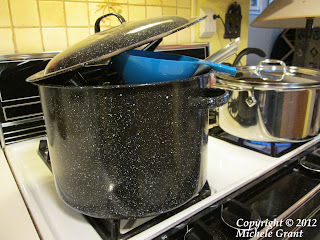To maintain my sanity, I store the plasticware containers and their lids separately. When I try to put everything into one large bin, the lids seem to jumble themselves to the bottom of the bin and get lost. Or they don't, and they prevent the containers from nesting neatly, so that the stacks of containers become an unwieldy pile and topple over into the floor of the cabinet. It's a little thing, but consider that if it takes you 15 seconds to find a container and its lid, and you need to retrieve a container twice per day (once for your sack lunch and once for putting away dinner leftovers), then you've spent 30 seconds a day, or just over 3 hours per year, fiddling in the plasticware bin. Cut that down to 15 seconds a day, and it's still stupid math, but let's continue. My point, and I had one, is that I keep the plasticware tubs in that oversized bin, but I store the lids separately in an oversized ziploc-type bag placed next to the bin. Saves some time and grief.
And that bag is the barometer that tells me when it's time to purge my plasticware. When I'm having trouble cramming all my lids in the bag, it's time to pull out the bin and start tossing plasticware. How to choose what to throw out? Start with problematic pieces:
With any luck, you're back down to a reasonable number of containers. But if the bin is still overstuffed, toss these:
Now, those super-tiny containers can be useful elsewhere in the home: thumbtacks, other hardware, buttons, beads, paperclips, epoxy-mixing, whatever. As for the kitchen, forget it. Plastic tubs are ugly for storing spices, and American slapstick comedy teaches us that inevitably you will open them with a jostle that spills spices all over the kitchen. Better to keep spices in the packages you buy them in, or use jelly jars.
If you're extra lucky, you can discard these containers in your curbside recycling. Last time I purged, everything I tossed was #5 plastic, which Philadelphia happily collects in my commingled recyc bin. Or you can try to think of a way to re-use containers, especially the larger ones. For example, we keep a small home remedies kit (band-aids, thermometer, cold symptom relief pills, etc.) in a box-shaped quart-size bin in the cabinet above the kitchen sink. I've containerized our nail clippers and tweezers on a medicine cabinet shelf in the bathroom. And I store our emergency candles and matches in containers in my living room dresser. All utilitarian stuff that I don't have to look at on an open shelf and don't use every day.
So to wrap up the process. Once I've purged down to a reasonable amount of plasticware -- maybe a dozen pieces, at the absolute most -- then I clean the storage bin and replace the lid storage bag. And now I'm good to go for six months to a year. Now to go and purge the singleton socks from my underwear drawer.






